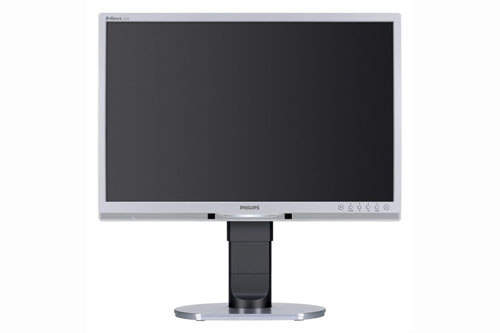Philips Brilliance 225B monitor review
Philips says the infrared sensor inside its 225B monitor can tell when you're not in front of it and drop the brightness and power. We put it to the test.
The PowerSensor on the Philips does the job and lowers screen brightness and therefore power consumption when you're literally out of the picture. Of course, you can get superior image quality for the money, but if you're more concerned with keeping those power costs down this monitor is one to keep in the frame.



Philips Brilliance 225B
While most monitors can viewed as much of a muchness in terms of features, with the Brilliance 225B Philips cannot be accused of not trying something different.
Taking it out of the box, the 225B admittedly does look much like your average 22in, 1,680 x ,1050 resolution display - silver bezel, buttons at the bottom right, name at the top left.
What's different here is not the slightly tacky blue light underneath the Philips logo but the two black squares placed on the speaker bar at the bottom.
These infra-red sensors are evidence of a feature dubbed by Philips as PowerSensor'. The idea is that the monitor can detect when you're not actually sitting in front of your machine and dim the screen automatically, dropping the power consumption from the default of 40 watts, to 20 watts, in order to save on those energy bills - something no company is going to argue about in the current climate or any other.
This is all fine and dandy as an idea but in practice it is a little tricky to set up. The sensor has five settings Off, 1, 2, 3, and 4, with four being the most powerful, and the range is given as 30cm 120cm. This means that when you're sitting very, very, close to the screen, you'll use setting one, but if further away you'll need use a higher setting.
The default is set to 3, but we found that sitting a perfectly normal distance from the display at our desk, unless we used setting 4, the monitor couldn't detect our presence, and dropped into powersaving mode, with a rather irritating 'PowerSensor Saving Mode ON' message appearing bang in the middle of the screen. This disappears as soon as you move back in front of the screen however.
Get the ITPro daily newsletter
Sign up today and you will receive a free copy of our Future Focus 2025 report - the leading guidance on AI, cybersecurity and other IT challenges as per 700+ senior executives
Benny Har-Even is a twenty-year stalwart of technology journalism who is passionate about all areas of the industry, but telecoms and mobile and home entertainment are among his chief interests. He has written for many of the leading tech publications in the UK, such as PC Pro and Wired, and previously held the position of technology editor at ITPro before regularly contributing as a freelancer.
Known affectionately as a ‘geek’ to his friends, his passion has seen him land opportunities to speak about technology on BBC television broadcasts, as well as a number of speaking engagements at industry events.
-
 Cleo attack victim list grows as Hertz confirms customer data stolen – and security experts say it won't be the last
Cleo attack victim list grows as Hertz confirms customer data stolen – and security experts say it won't be the lastNews Hertz has confirmed it suffered a data breach as a result of the Cleo zero-day vulnerability in late 2024, with the car rental giant warning that customer data was stolen.
By Ross Kelly Published
-
 Women show more team spirit when it comes to cybersecurity, yet they're still missing out on opportunities
Women show more team spirit when it comes to cybersecurity, yet they're still missing out on opportunitiesNews While they're more likely to believe that responsibility should be shared, women are less likely to get the necessary training
By Emma Woollacott Published
-
 OpenAI wants developers using its new GPT-4.1 models – but how do they compare to Claude and Gemini on coding tasks?
OpenAI wants developers using its new GPT-4.1 models – but how do they compare to Claude and Gemini on coding tasks?News OpenAI says its GPT-4.1 model family offers sizable improvements for coding, but tests show competitors still outperform it in key areas.
By Ross Kelly Published